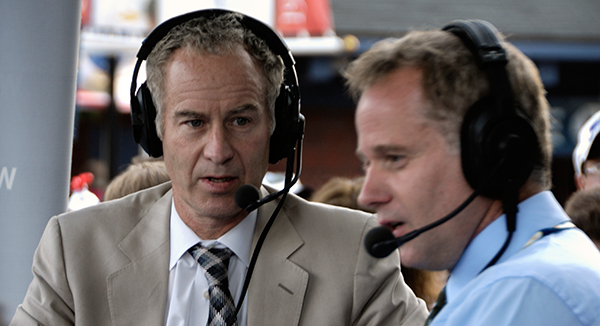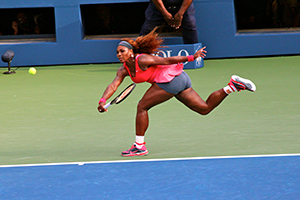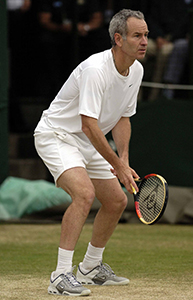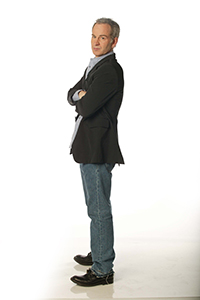Excitement Looms at the 2015 US Open

By Lyle Seltzer and Bob Nesoff
Tennis fans are eagerly awaiting the opening of the U.S. Open at the end of this month with a special focus on Serena Williams and her quest for a Grand Slam.
The tournament commences at 11am on Monday, August 31 and runs through Sunday, September 13 with the men’s final slated for Sunday, September 13th and the women’s final slated for Saturday, September 12th.
The tournament, played at the USTA Billie Jean King National Tennis Center in Flushing Meadows - Corona Park, will be broadcast by ESPN. This year’s broadcast is the first of a new 11 year deal between ESPN and the U.S. Tennis Association. ESPN’s US Open coverage now will include Labor day weekend and finals weekend windows that were broadcast by CBS for more than 40 years.
John McEnroe, one of the greatest tennis players of all time and probably the most knowledgeable and interesting tennis analyst, will once again be part of the network broadcast team continuing the role he has played in prior years.
Viewers look to John for his tennis insight and he plays a major role in the event based on his relationships with current players, past players and coaches. He is a fixture at the Open and fans talk not only about his announcing skills but also compare the top current players skills and personalities to John’s days as a tennis player when he won 7 major championships. John is a true New Yorker and a home town favorite having grown up in Douglaston, Queens and currently living in New York City.
The 2015 tournament is shaping up to be full of excitement on both the men’s and women’s side. On the men’s side, Novak Djokovic fresh off his 2015 victory at Wimbledon will face a strong group of challengers. Roger Federer, the Wimbledon runner-up and five time US Open champion, is playing at the top of his game and is seeking the same type of major victory in the twilight of his career that Pete Sampras pulled off in his 2002 US Open victory against Andre Agassi. Rafael Nadal a one time US Open winner is always a strong contender sporting a .500 victory percentage against Djokovic but with only a hard court record of 6-13. Tune in to hear John’s analysis which goes far beyond just the numbers and see if he can predict who the sleepers may be.

On the women’s side it’s all about Serena Williams and her quest to win a grand slam and be the first player in 27 years to win a calendar year grand slam. Basically, it’s her tournament unless she has an off day and beats herself. She is preceded in winning a Calendar year Grand Slam only by the likes of Rod Laver (1969), Margaret Court (1970) and Steffi Graf (1988). Much of the smart money is betting on her to take the title.
Tune in to hear John’s analysis of what tactics Serena’s opponents need to muster up to pull off an upset.
If you get a chance, come out and watch the US Open in person. Day session matches start at 11am and you have a wide choice of matches to watch in the early rounds. You can walk around the grounds and watch matches being played on the side courts, the grandstand, Louis Armstrong Stadium as well as Arthur Ashe Stadium. The grounds are pretty and you can enjoy a nice lunch from the wide selection of booths in the food court. Stop by the booths manned by apparel vendors and bring home a nice souvenir. Most evening sessions start at 7pm and the crowd is mostly the after work crowd. The number of matches being played in the night session are more limited than the day sessions. Pick your favorite players and follow the two week tournament either in person or on TV. You are sure to be entertained.
Tennis fans flocked to the courts to see John McEnroe take on the guys sitting on the lifeguard chairs at courtside. It was almost a given that he would spew invective at them, questioning their eyesight, intelligence or ability if they made a call that went against him.
Tennis today is a bit more sophisticated and placid with fans coming out to cheer on the Williams sisters, Novak Djokovic and the other talented players. They know who won. They know the rules of the game. They want to see the talent.

Now that’s not to say that McEnroe was any less talented than today’s players. If he was still on the court he could probably hold his own against the best of them. After all, he was one of the best players in the history of the game.
While the talent pool in tennis today is as good as it ever has been, there’s a bit of panache missing; the drama is in the play and not the side play. Where is John McEnroe when you need him?
McEnroe’s early years were unusual in that he was born in Wiesbaden, Germany while his father was serving in the Air Force. The disciplined life of a military brat obviously didn’t wear off on him considering his antics on the court. But perhaps that same discipline was what made him into the top caliber professional he did become.
“When he was only two years old he was able to hit a ball with a plastic bat,” commented his father, John Sr. “At age four he could hit it quite a distance.”
That hand/eye coordination would develop as he grew and was invaluable on the tennis court.
From Germany the family moved to Queens and John grew up in Douglaston and tennis became his sport. In 1977, following high school graduation, he went to Europe for a tennis tournament and won the French Juniors Tournament. He next went for the junior title at Wimbledon but withdrew when he qualified for the men’s competition.
At 18-years-old he dumbfounded everyone by reaching the semi-finals only to lose to Jimmy Connors. He soon had a solid reputation as one of tennis’ “Bad Boys,” along with Connors and Ilie Nastase who earned the sobriquet “Nasty Nastase.”
Named “Rookie of the Year” in 1977 despite inconsistent play, a sportswriter commented: “He is a young man who raised perfectly placed strokes to a high art form only to resort to tantrums that smear his masterpiece like graffiti.”
In 1978 he began his assault on the U.S. Open, reaching the semi-finals. By the end of the year he was ranked sixth in the world in singles and fifth in doubles. Perhaps that led tennis legend Tony Trabert to take him under his wing to play in the Davis Cup.
McEnroe, contrary to his later escapades, handled the pressure exceptionally well and was a big factor in helping the United States to its first Davis Cup victory in six years. Moving on, he beat top names such as Bjorn Borg and began cementing his own reputation.
But his on-court antics earned him the sobriquet “Super Brat” by the British press. His turns at Wimbledon brought out the British television audience almost unanimously there hoping to see him lose. As in 1776 the Brits lost once again.
John showed his mettle in 1980 in his hot rivalry against Borg at the U.S. Open with McEnroe emerging victorious. This was a prelude to the following year (1981) when McEnroe took a four-set win, following that with wins in three consecutive years, becoming the first man since Bill Tilden to take three consecutive U.S. Open titles. He set a record by capturing 28 Davis Cup singles victories and in 1984 he won 82 of 85 matches.
In 1986 he stepped away from play to recharge his batteries and then the following year did so involuntarily when he was suspended for an outburst on the court. He packed it in during 1992 with seven career Grand Slam singles championships; nine Grand Slam doubles titles and another in mixed doubles.
Tennis enacted a limit of $7,500 in fines before a player would be suspended. To the surprise of no one, the rule was put in place as a result of McEnroe’s on-court histrionics. He earned a suspension under that rule in 1984 after an outburst that became what today would be called “viral.”
He questioned a chair umpire’s call and went on a rant demanding: “Answer my question! The question, jerk.” He then slammed his racquet into a juice cart that was innocently nearby. That cost him 21 days for eclipsing the $7,500 fine threshold.

Out of the maelstrom of tournament play, McEnroe became a sports broadcaster for television and still competes in a number of charity tournaments. He is especially interested in children’s causes and is very active with the Arthur Ashe Foundation working to eliminate AIDS.
More in line with his ability on the court than his antics, he was inducted into the International Tennis Hall of Fame and was named captain of the Davis Cup team in 1999.
John always had a wide range of interests. As an avid rock fan, he plays guitar and sometimes gives a performance at charity events. He learned to play with the assistance of such notables as Eddie Van Halen and Eric Clapton. He formed a band called the “Johnny Smyth Band,” and acted as lead singer. He also wrote music and songs.
Interested in art as well, he opened the John McEnroe Art Gallery in New York, offering an opportunity for young artists to display their works.
He turned to acting and his career flourished with McEnroe playing himself on everything from sitcoms to cartoon shows. He played himself in “Mr. Deeds” and again in the critically panned “You Don’t Mess With The Zohan.”
In television commercials, he managed tongue-in-cheek antics by parodying himself, throwing a hissy-fit and stomping around. He was featured in a British insurance company’s commercial putting on his on-court outburst.
In a funny move, chess champion Freddie Trumper, who had much the same reputation, while in the musical “Chess,” said: “I don’t believe that they can’t see my game. I’m like that tennis player, what’s-his-name.”
The fact of the matter; however, is that John McEnroe will be remembered as one of the best tennis players in the world long after his outbursts are forgotten.


